 |
 |
 |
| |
IMPACT OF BASELINE GENOTYPIC RESISTANCE ON RESPONSE TO TIPRANAVIR/r in RESIST STUDIES
|
| |
| |
Report by Jules Levin
At CROI today Johnathan Schapiro reported in an oral presentation the impact of baseline genotypic resistance on the response to tipranavir (TPV/r) in treatment-experienced patients in the phase III RESIST-1 & RESIST -2 trials.
AUTHOR CONCLUSIONS:
--For the combined RESIST studies at week 24, 41% TPV/r patients achieved a treatment response (1 log or more viral load reduction) compared with 18.9% of patients receiving comparator PI boosted (CPI/r) regimen.
--TPV/r-based therapy was consistently superior to CPI/r for this patient population regardless of total baseline protease mutations, number of primary mutations, and number of UPAMs
--TPV/r provides effective therapy in triple-class, 2 PI-experienced patients
To enter these studies patients must've had at least 2 PI regimens, and 1 or more primary PI mutations at codons 30N, 46I/L, 48V, 50V, 82A/F/L/T, 84V, or 90M, and 2 or less of these mutations—33, 82, 84, or 90. However, the results of this analysis show these 4 latter mutations are not as relevant to tipranavir resistance as previously thought.
Treatment response is defined as confirmed 1 log or more reduction in viral load from baseline by week 24 without viral rebound, treatment change, or study discontinuation.
Patients in this study received resistance testing & then selected their optimized background regimen (OBR). Then they were randomized to TPV/r or CPI/r (comparator PI regimen: LPV/r, IDV/r, or APV/r). Failures in CPI arm after week 8 could receive TPV in rollover study.
In the 2 RESIST studies 582 patients received TPV/r & 577 received CPI/r. 87% were men. The median baseline HIV RNA was 67,000 copies/ml (4.83 log copies/ml). Median baseline CD4 count was low: 155 cells.
The study patients were very treatment-experienced with extensive PI resistance. Patients had an average of 12 antiretroviral drugs before this study. Patients had on average 3 protease inhibitors and ritonavir for boosting prior to this study. 45% of patients had 5 or more PIs before this study; 25% had 4 PIs before the study, 18% had 3 PIs before this study. Study patients had an average of 6 NRTIs before this study, and 12% had previous T-20 treatment.
60% of study patients had 3-4 primary PI mutations; 37% had 1-2 primary PI mutations; o.5% had 0 primary mutations. 50% of patients had at least 16 PI mutations. 20% of patients had 12 or less PI mutations.
BASELINE PHENOTYPIC SUSCEPTIBILITY (VIRCO)
Median resistance (fold-change) to
TPV/r: 1.7
LPV/r: 87.4
IDV: 41.0
SQV: 20.1
APV: 12.2
NFV: 40.7
RTV: 194.7
ATZ: 55.3
Patients had 12-fold resistance or greater to every PI except to TPV before starting the study.
TPV RESIST Studies
Proportion With Treatment Response (>=1 log Viral load Reduction)
TPV/r: 41.2% had treatment Response vs
CPI/r: 18.9% had Treatment Response
TREATMENT RESPONSE at week 24 According to Baseline Protease Mutations
|
|
| |
| |
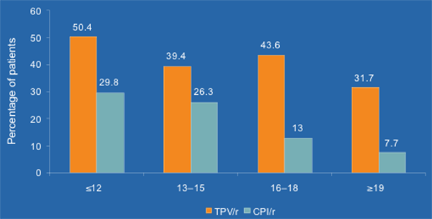 |
|
| |
| |
Change in Viral Load at Week 24 According to Baseline Protease Mutations
|
|
| |
| |
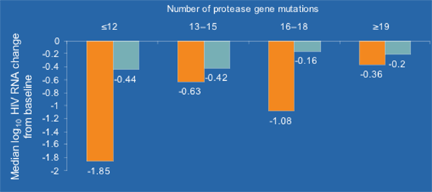 |
|
| |
| |
Treatment response at week 24 According to Number of Baseline Primary Mutations
|
|
| |
| |
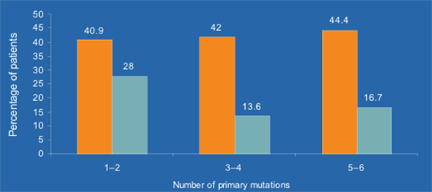 |
|
| |
| |
Change in Viral Load at Week 24 According to Number of Baseline Primary Mutations
|
|
| |
| |
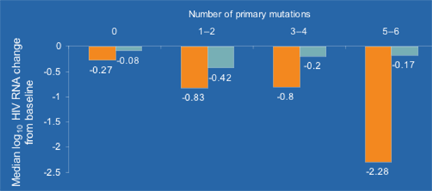 |
|
| |
| |
Treatment response at week 24 According to Number of Baseline UPAMs (mutations at codons 33, 82, 84, & 90)
|
|
| |
| |
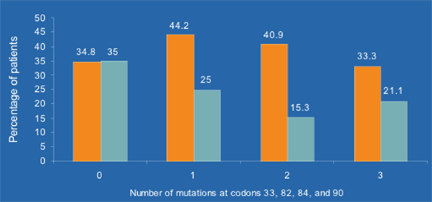 |
|
| |
| |
These data show that UPAMs did not predict resistance. Prior to this study it was thought that having 2 or more of these mutations would predict resistance to TPV/r but as you can see having 2 or 3 UPAMs did not result in worse response by TPV/r. In fact 33-40% of patients with 2-3 UPAMs had treatment response.
Change in Viral load at Week 24 According to Number of Baseline UPAMs
|
|
| |
| |
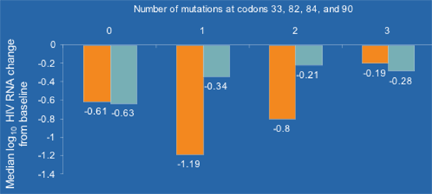 |
|
| |
| |
|
| |
|
 |
 |
|
|